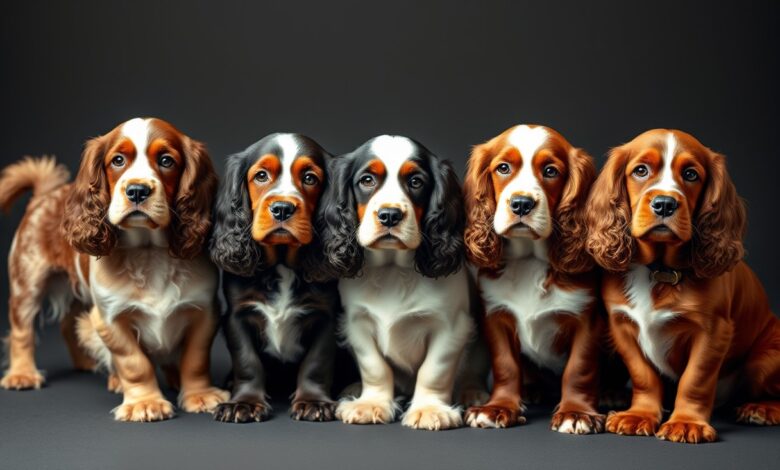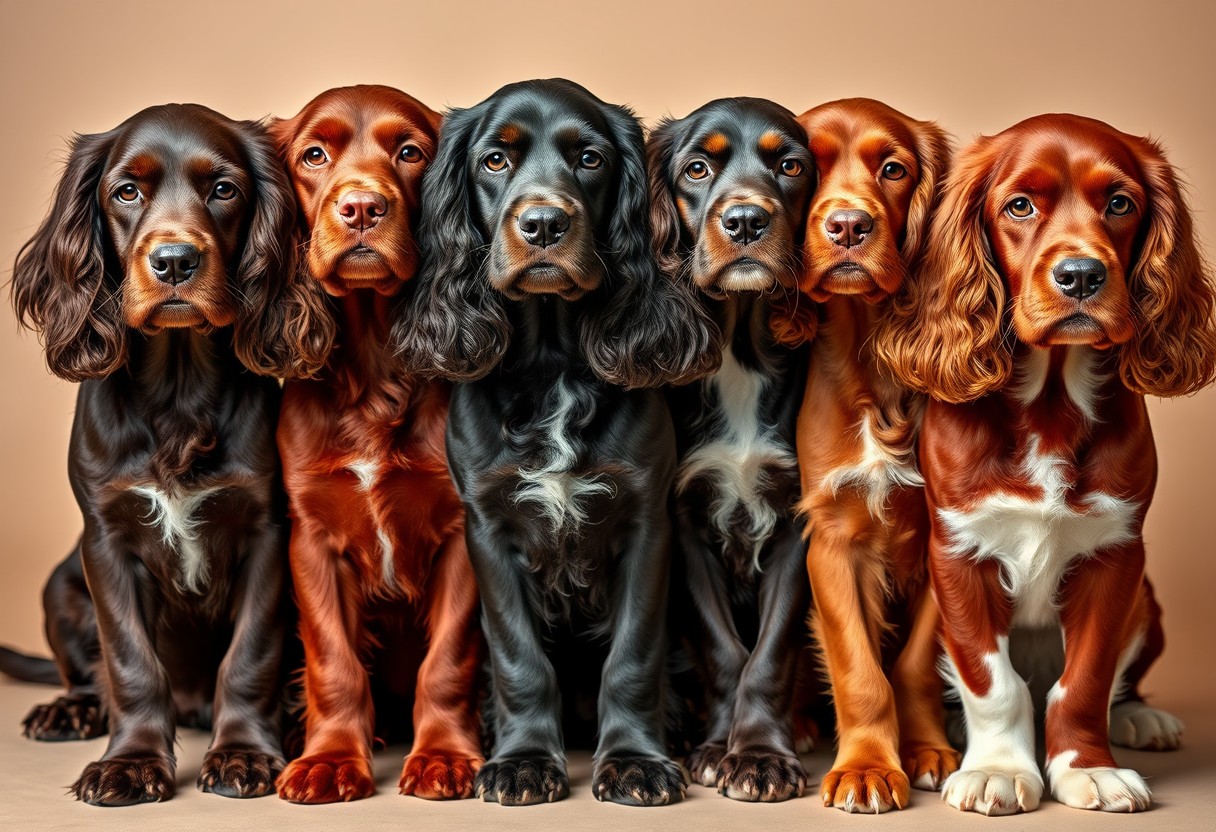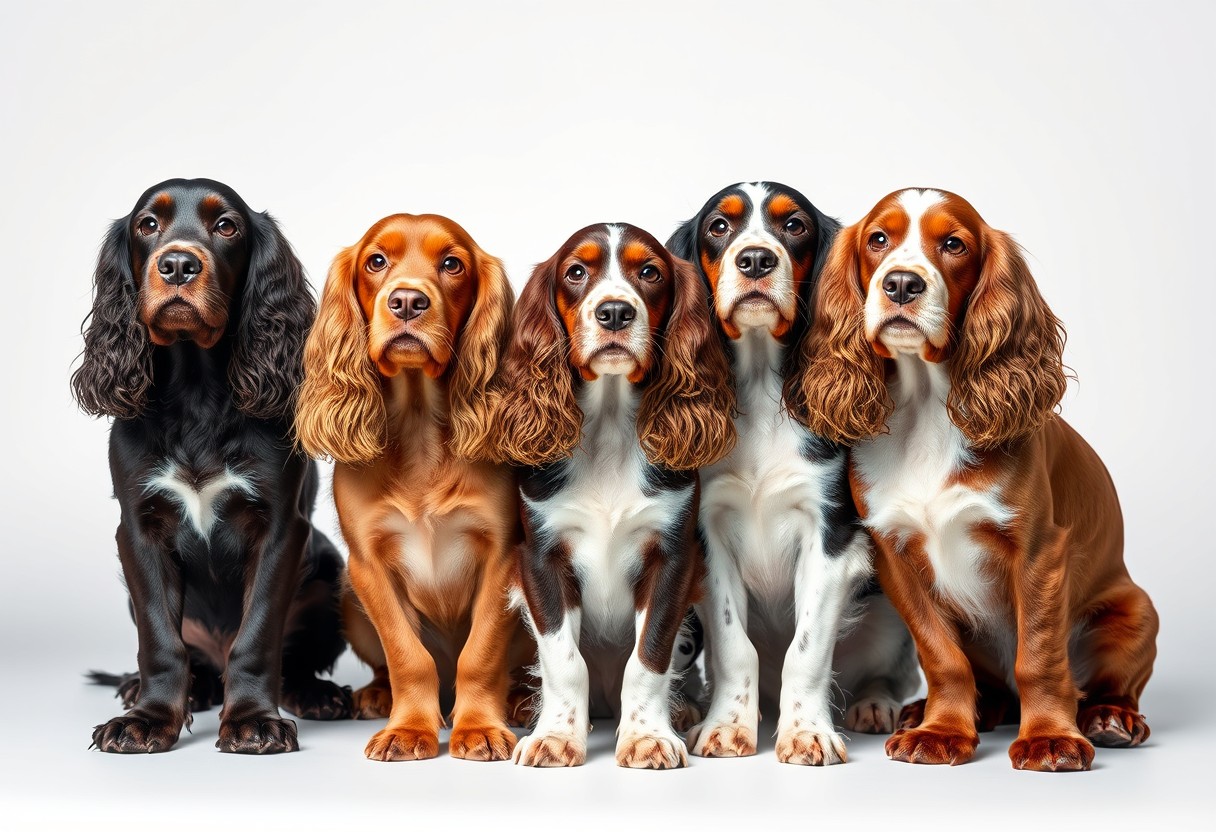Rare English Cocker Spaniel Colors – Top 5 Most Unique Shades

You may be surprised to learn that English Cocker Spaniels come in various stunning and rare colors. While the common shades are well-known, some unique hues can truly set your furry friend apart. In this blog post, we’ll explore the top five most distinct shades of English Cocker Spaniels, making it easier for you to appreciate the beauty and variety within this beloved breed. Whether you’re thinking of adopting or just curious about these rare colors, this guide will help you understand what makes each hue special.

Key Takeaways:
- Unique colors: Rare shades of English Cocker Spaniels include stunning variations like chocolate merle and blue roan, which stand out in the breed.
- Genetics influence: The variation in coat colors is a result of genetic combinations; understanding these can help prospective owners find their desired shade.
- Market demand: Unique coat colors can impact the pricing and availability of these dogs, often making rarer colors more sought after in the pet market.
The Importance of Coat Color in Cocker Spaniels
To understand the charm of Cocker Spaniels, you must appreciate the significance of their coat color. The color of your Cocker Spaniel not only contributes to its overall appeal but can also affect how others perceive your dog. Rare shades often catch the eye and make a statement, showing the uniqueness that lies within this beloved breed. Your choice of color may even influence breeding decisions, showcasing your preference for specific aesthetics.
Historical Perspective
For centuries, color preferences in Cocker Spaniels have evolved, reflecting societal trends and breeding practices. Early Cocker Spaniels were bred primarily for function, with less emphasis on color; however, as the breed gained popularity, certain shades began to dominate, such as black, liver, and golden. The demand for specific colors led to selective breeding techniques, resulting in the establishment of trends that still influence your choices today. (One pivotal decision was the introduction of color classifications in breeding competitions.)
Breed Standards and Color
Perspective reveals that official breed standards are imperative in dictating acceptable colors for Cocker Spaniels. The American Kennel Club (AKC) has established guidelines that have evolved significantly over the years, shaping the expectations for breeders and owners alike. Rare colors, such as merle and blue roan, are often met with skepticism, as they may not fit within the traditional standards. However, these colors are increasingly appreciated for their beauty, prompting discussions about their place in the future of the breed.
Spaniels are not just delightful companions; they represent a living history of breeding and selection. The evolution of breed standards highlights the balance between tradition and the appreciation for variety. As you explore the fascinating world of Cocker Spaniel colors, you may find that embracing rare shades opens up new dimensions in your connection with the breed. It’s important to stay informed about how changing standards may impact your decisions, as some colors could gain recognition while others may remain outside the spotlight.
Top 5 Most Unique Rare Colors
Clearly, the English Cocker Spaniel presents an array of stunning and rare colors that captivate dog enthusiasts. Each unique shade offers distinctive characteristics and stands out among the breed. The following overview highlights the top five most unique rare colors, showcasing their genetic backgrounds and attributes, so you can appreciate their beauty and rarity.
Reddish Gold
At the core of its appeal, reddish gold exhibits a warm, rich hue that embodies the breed’s charm. This color is considered rare due to its limited prevalence compared to more common shades like black or liver. The vibrant reddish undertones give these dogs a striking appearance, making them highly sought after in the breed community.
Blue Roan
Among the elite colors, blue roan stands out for its unique speckled appearance, combining both black and white hairs. The genetics behind this coloration involve a specific allele that produces the roan pattern, which has become a favorite among enthusiasts. It’s crucial to understand this unique color to appreciate its beauty and significance in breeding decisions. (Investing in a blue roan may add significant value to your breeding program.)
Further, blue roan Cocker Spaniels are often favored for their distinct look and aura. They maintain an elegant balance between striking appearance and timeless breed standards. (Ensure your breeding choices are informed by reputable sources to maintain quality.)
Chocolate Merle
Against the backdrop of the classic chocolate color, the chocolate merle pattern introduces a captivating swirl of lighter and darker shades. This coloration remains rare and often elicited debate within breeding circles about its acceptance and standardization. The complexity involved in breeding chocolate merles should prompt careful consideration and attention to ethical guidelines.
In addition, the chocolate merle is not only aesthetically stunning but also raises concerns regarding genetic health as it may lead to specific health issues. It’s vital for breeders to prioritize health alongside desired traits in their lineage. (Prior focus on genetics will ensure you make responsible breeding choices.)
Silver Blue
With an intriguing blend of gray and blue tones, silver blue presents a unique and captivating appearance. The inheritance patterns of this color can be complex, often stemming from the dilution of black. Its increasing popularity in certain regions highlights its appeal within the cocker spaniel community. (Be mindful of regional preferences to make informed breeding decisions.)
Any enthusiasts seeking a silver blue Cocker Spaniel must be prepared for their rarity, which may come with higher costs and demand. Understanding these trends will better prepare you for responsible acquisition or breeding. (Prioritizing genuine breed standards will serve your breeding objectives.)
Apricot
Astonishingly, apricot is not only vibrant but offers a unique genetic background separate from the more common colors. This hue captures the soft, warm essence of the breed and stands out amidst a sea of traditional colors. When contrasted with other common shades, apricot shines brightly, drawing attention to its exceptional qualities. (Being aware of genetic diversity is crucial for ethical breeding practices.)
Blue-tinted shadows highlight the apricot’s uniqueness, making it a desirable choice for those who appreciate rare colors in the breed. Embracing this distinctive hue can elevate your understanding of breed diversity. (Ultimately, informed decisions in breeding will enhance the spaniel’s future heritage.)

Rarity and Market Demand
Keep in mind that the rarity of certain Cocker Spaniel colors significantly influences their market value. Breeders assess these unique hues, often setting higher prices for rarer shades, which in turn attracts collectors eager to own something exceptional. The dynamics of supply and demand create a niche market for these dogs, leading to increased competition and potential for profitability. (Ultimately, carefully consider how much you are willing to pay for such unique traits.)
The Collector’s Eye
Below the surface of rarity lies the keen observation of collectors who seek unique Cocker Spaniel colors. They often evaluate the pedigree, lineage, and breeding practices that produce these rare shades, making them pivotal in determining a dog’s market value. These collectors play a vital role, influencing breeders’ choices and pushing for higher standards in rarity. (It’s imperative to weigh the motivations behind the pursuit of rare colors.)
Ethical Considerations in Breeding
To engage in breeding for rare colors, you must address the ethical implications of your choices. Prioritizing the health and welfare of the dog over aesthetics is non-negotiable, as breeding solely for color can lead to serious health issues and decreased overall well-being. Combining health-focused practices with the aim for rarity can guide you in making responsible breeding decisions. (Your commitment to ethical breeding practices can significantly impact the future of the breed.)
Consequently, maintaining a balance between breeding for unique colors and ensuring the dog’s health is paramount. The focus should always be on adhering to responsible breeding practices that prevent inherited health issues while still appreciating the beauty of rare colors. If the pursuit of a unique appearance compromises the welfare of the breeding stock, the responsibility falls on you to reconsider your approach. (Choosing ethical practices will lead to better outcomes for the breed and the dogs you cherish.)

Caring for Rare-Colored Cocker Spaniels
Despite their unique appearances, rare-colored Cocker Spaniels require the same dedication and care as their more common counterparts. Providing you keep their genetic needs and grooming requirements in mind, your dog will thrive. With the right approach to their grooming, health, and well-being, you can ensure that your rare-colored Cocker Spaniel not only looks stunning but also remains happy and healthy.
Grooming and Maintenance
RareColored Cocker Spaniels demand special grooming attention, particularly to address their unique shades. You should regularly brush their coat to avoid matting and tangling while paying special attention to skincare, especially for lighter colors that may be prone to sunburn. Bathing should be done every 4 to 6 weeks, utilizing gentle, color-safe shampoos, while regular nail trimming and ear cleaning are also necessary to maintain their overall health.
Health Considerations
Above all, being aware of health issues associated with specific colors is vital. Certain rare shades may predispose your Cocker Spaniel to genetic concerns such as progressive retinal atrophy or skin sensitivities. You can mitigate risks by sourcing your puppy from a reputable breeder, ensuring health screenings are performed for both parents. Regular vet check-ups and a tailored diet can further promote your dog’s longevity and health.
And while health issues tied to rare colors exist, the majority can be managed with proper awareness and care. Specific conditions related to color, such as decreased immune response or hearing issues, may arise; thus, staying vigilant for any symptoms is paramount. Engage with your veterinarian to establish a proactive care routine that prioritizes your Cocker Spaniel’s unique needs, reinforcing their health and well-being.
Conclusion
The exploration of rare English Cocker Spaniel colors reveals a fascinating spectrum that elevates your understanding of this beloved breed. From unique shades like chocolate roan to sable, these colors contribute to the distinctiveness of your Cocker Spaniel. As you bond with your pet, you may appreciate the beauty of their coat even more. For a deeper look into the variety of Cocker Spaniel colors, you can check out 24 Cocker Spaniel Colors & Patterns (With Pictures) to help celebrate the remarkable beauty of your furry companion.
FAQ
Q: What are the rarest colors found in English Cocker Spaniels?
A: The rarest colors found in English Cocker Spaniels include Silver, Roan (Blue and Chocolate), and various shades of Cream and Gold. While the traditional colors like Black, Liver, and Red are common, these unique hues stand out and can be quite mesmerizing. Silver Cocker Spaniels, for instance, are noted for their striking appearance and are often sought after by breeders and pet owners alike.
Q: How does coat color affect the temperament of English Cocker Spaniels?
A: Coat color does not inherently affect the temperament of English Cocker Spaniels. Differences in behavior and personality are primarily influenced by genetics, training, and socialization rather than the color of the coat. Regardless of color, Cocker Spaniels are known for their friendly disposition, intelligence, and playful nature, making them excellent companions.
Q: Are rare-colored Cocker Spaniels more expensive than standard ones?
A: Yes, rare-colored English Cocker Spaniels often come with a higher price tag compared to their more common counterparts. Breeders may charge a premium for unique shades, reflecting their rarity and desirability in the pet market. Potential owners should always ensure they’re working with reputable breeders who prioritize health and temperament over color when considering a rare-colored Cocker Spaniel.





